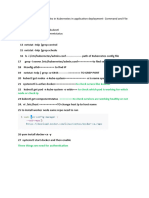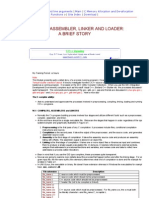kubectl run <pod-name> --image=<image-name> --namespace=<namespace>
Service YAML (redis-service.yaml):
apiVersion: v1
kind: Service
metadata:
name: redis-service
namespace: finance
spec:
selector:
app: redis
ports:
- protocol: TCP
port: 6379
targetPort: 6379
type: ClusterIP
ReplicationController YAML (redis-rc.yaml):
apiVersion: v1
kind: ReplicationController
metadata:
name: redis-rc
namespace: finance
spec:
replicas: 3
selector:
app: redis
template:
metadata:
labels:
app: redis
spec:
containers:
- name: redis
image: redis
ports:
- containerPort: 6379
Deployment YAML (redis-deployment.yaml):
apiVersion: apps/v1
kind: Deployment
metadata:
name: redis-deployment
namespace: finance
spec:
replicas: 3
selector:
matchLabels:
app: redis
template:
metadata:
labels:
app: redis
spec:
containers:
- name: redis
image: redis
ports:
- containerPort: 6379
kubectl run nginx --image=nginx --dry-run=client -o yaml > nginx-pod.yaml
Certification Tip: Imperative Commands
While you would be working mostly the declarative way - using definition files,
imperative commands can help in getting one-time tasks done quickly, as well as
generate a definition template easily. This would help save a considerable amount
of time during your exams.
Before we begin, familiarize yourself with the two options that can come in handy
while working with the below commands:
--dry-run: By default, as soon as the command is run, the resource will be created.
If you simply want to test your command, use the --dry-run=client option. This will
not create the resource. Instead, tell you whether the resource can be created and
if your command is right.
-o yaml: This will output the resource definition in YAML format on the screen.
Use the above two in combination along with Linux output redirection to generate a
resource definition file quickly, that you can then modify and create resources as
required, instead of creating the files from scratch.
kubectl run nginx --image=nginx --dry-run=client -o yaml > nginx-pod.yaml
POD
Create an NGINX Pod
kubectl run nginx --image=nginx
Generate POD Manifest YAML file (-o yaml). Don't create it(--dry-run)
kubectl run nginx --image=nginx --dry-run=client -o yaml
Deployment
Create a deployment
kubectl create deployment --image=nginx nginx
Generate Deployment YAML file (-o yaml). Don't create it(--dry-run)
kubectl create deployment --image=nginx nginx --dry-run -o yaml
Generate Deployment with 4 Replicas
kubectl create deployment nginx --image=nginx --replicas=4
You can also scale deployment using the kubectl scale command.
kubectl scale deployment nginx --replicas=4
Another way to do this is to save the YAML definition to a file and modify
kubectl create deployment nginx --image=nginx--dry-run=client -o yaml > nginx-
deployment.yaml
You can then update the YAML file with the replicas or any other field before
creating the deployment.
Service
Create a Service named redis-service of type ClusterIP to expose pod redis on port
6379
kubectl expose pod redis --port=6379 --name redis-service --dry-run=client -o yaml
(This will automatically use the pod's labels as selectors)
Or
kubectl create service clusterip redis --tcp=6379:6379 --dry-run=client -o yaml
(This will not use the pods' labels as selectors; instead it will assume selectors
as app=redis. You cannot pass in selectors as an option. So it does not work well
if your pod has a different label set. So generate the file and modify the
selectors before creating the service)
Create a Service named nginx of type NodePort to expose pod nginx's port 80 on port
30080 on the nodes:
kubectl expose pod nginx --port=80 --name nginx-service --type=NodePort --dry-
run=client -o yaml
(This will automatically use the pod's labels as selectors, but you cannot specify
the node port. You have to generate a definition file and then add the node port in
manually before creating the service with the pod.)
Or
kubectl create service nodeport nginx --tcp=80:80 --node-port=30080 --dry-
run=client -o yaml
(This will not use the pods' labels as selectors)
Both the above commands have their own challenges. While one of it cannot accept a
selector the other cannot accept a node port. I would recommend going with the
`kubectl expose` command. If you need to specify a node port, generate a definition
file using the same command and manually input the nodeport before creating the
service.
Reference:
https://kubernetes.io/docs/reference/kubectl/conventions/
---------------------
1. Core Concepts (13%)
Understand Kubernetes API primitives:
What are Pods, Services, Deployments, and StatefulSets?
How do you use ConfigMaps and Secrets?
How do you use Namespaces and Labels?
Create and configure basic Pods:
How do you create a Pod using kubectl run and kubectl create?
How do you configure a Pod with environment variables?
2. Configuration (18%)
Understand ConfigMaps:
How do you create and use ConfigMaps?
How do you mount a ConfigMap as a volume?
Understand Secrets:
How do you create and use Secrets?
How do you mount a Secret as a volume?
Define and create applications using Kubernetes resources:
How do you use kubectl apply to create resources?
How do you create and manage Deployments, StatefulSets, and DaemonSets?
3. Multi-Container Pods (10%)
Understand Pod design:
How do you create multi-container Pods?
What are the different types of multi-container Pod patterns (e.g., sidecar,
ambassador, adapter)?
4. Observability (18%)
Understand Liveness and Readiness Probes:
How do you configure Liveness and Readiness probes in a Pod?
Understand container logging:
How do you access logs for a container using kubectl logs?
Understand monitoring and debugging:
How do you use kubectl describe to inspect resources?
How do you use kubectl exec to interact with a container?
5. Pod Design (20%)
Understand Labels, Selectors, and Annotations:
How do you use labels and selectors to organize resources?
How do you use annotations to store non-identifying metadata?
Understand resource requests and limits:
How do you set resource requests and limits for Pods?
Understand service discovery and networking:
How do you create and manage Services?
What are the different types of Services (ClusterIP, NodePort, LoadBalancer)?
6. State Persistence (8%)
Understand PersistentVolumeClaims for state persistence:
How do you create and use PersistentVolumes and PersistentVolumeClaims?
7. Services & Networking (13%)
Understand Services:
How do you create and manage Services (ClusterIP, NodePort, LoadBalancer)?
How do you use Network Policies to control network access?
Understand Ingress:
How do you configure and use Ingress resources for HTTP and HTTPS routing?
Sample Questions:
Create a Pod with a specific image:
kubectl run nginx --image=nginx --restart=Never
Expose a Deployment as a Service:
kubectl expose deployment my-deployment --type=NodePort --port=80
Set resource limits on a Pod:
apiVersion: v1
kind: Pod
metadata:
name: my-pod
spec:
containers:
- name: my-container
image: my-image
resources:
limits:
memory: "128Mi"
cpu: "500m"
requests:
memory: "64Mi"
cpu: "250m"
Create a ConfigMap and use it in a Pod:
kubectl create configmap my-config --from-literal=key1=value1
apiVersion: v1
kind: Pod
metadata:
name: my-pod
spec:
containers:
- name: my-container
image: my-image
envFrom:
- configMapRef:
name: my-config
Add a Liveness and Readiness probe to a Pod:
apiVersion: v1
kind: Pod
metadata:
name: my-pod
spec:
containers:
- name: my-container
image: my-image
livenessProbe:
httpGet:
path: /healthz
port: 8080
initialDelaySeconds: 3
periodSeconds: 3
readinessProbe:
httpGet:
path: /readiness
port: 8080
initialDelaySeconds: 3
periodSeconds: 3
Scale a Deployment to 5 replicas:
kubectl scale deployment redis-deployment --replicas=5
Create an Ingress resource for HTTP and HTTPS routing:
apiVersion: networking.k8s.io/v1
kind: Ingress
metadata:
name: example-ingress
annotations:
nginx.ingress.kubernetes.io/rewrite-target: /
spec:
rules:
- host: example.com
http:
paths:
- path: /
pathType: Prefix
backend:
service:
name: example-service
port:
number: 80
Create a Pod with a liveness probe:
apiVersion: v1
kind: Pod
metadata:
name: liveness-pod
spec:
containers:
- name: my-container
image: nginx
livenessProbe:
httpGet:
path: /healthz
port: 80
initialDelaySeconds: 3
periodSeconds: 3
Create a PersistentVolume and PersistentVolumeClaim and mount it in a Pod:
apiVersion: v1
kind: PersistentVolume
metadata:
name: pv-volume
spec:
capacity:
storage: 1Gi
accessModes:
- ReadWriteOnce
hostPath:
path: "/mnt/data"
apiVersion: v1
kind: PersistentVolumeClaim
metadata:
name: pv-claim
spec:
accessModes:
- ReadWriteOnce
resources:
requests:
storage: 1Gi
apiVersion: v1
kind: Pod
metadata:
name: pv-pod
spec:
containers:
- name: my-container
image: nginx
volumeMounts:
- mountPath: "/usr/share/nginx/html"
name: pv-storage
volumes:
- name: pv-storage
persistentVolumeClaim:
claimName: pv-claim
Set resource requests and limits on a Pod:
apiVersion: v1
kind: Pod
metadata:
name: resource-pod
spec:
containers:
- name: my-container
image: nginx
resources:
requests:
memory: "64Mi"
cpu: "250m"
limits:
memory: "128Mi"
cpu: "500m"
Create a ConfigMap and use it in a Pod:
kubectl create configmap my-config --from-literal=key1=value1
apiVersion: v1
kind: Pod
metadata:
name: my-pod
spec:
containers:
- name: my-container
image: nginx
envFrom:
- configMapRef:
name: my-config
Get logs from a running Pod:
kubectl logs <pod-name>
Expose a Deployment as a ClusterIP service:
kubectl expose deployment redis-deployment --port=6379 --target-port=6379 --
type=ClusterIP
Create a Deployment with 3 replicas using the redis image:
kubectl create deployment redis-deployment --image=redis --replicas=3
Create a Pod with an Nginx container:
kubectl run nginx --image=nginx --restart=Never
Create a Deployment and roll out an update:
kubectl create deployment my-deployment --image=nginx:1.14
kubectl set image deployment/my-deployment nginx=nginx:1.15
Rollback a Deployment update:
kubectl rollout undo deployment/my-deployment
Create a Pod with a readiness probe:
apiVersion: v1
kind: Pod
metadata:
name: readiness-pod
spec:
containers:
- name: my-container
image: nginx
readinessProbe:
httpGet:
path: /ready
port: 80
initialDelaySeconds: 5
periodSeconds: 5
Create a ServiceAccount and use it in a Pod:
kubectl create serviceaccount my-serviceaccount
apiVersion: v1
kind: Pod
metadata:
name: serviceaccount-pod
spec:
serviceAccountName: my-serviceaccount
containers:
- name: my-container
image: nginx
Create a Horizontal Pod Autoscaler (HPA):
kubectl autoscale deployment my-deployment --cpu-percent=50 --min=1 --max=5
Create a Custom Resource Definition (CRD):
apiVersion: apiextensions.k8s.io/v1
kind: CustomResourceDefinition
metadata:
name: crontabs.stable.example.com
spec:
group: stable.example.com
versions:
- name: v1
served: true
storage: true
schema:
openAPIV3Schema:
type: object
properties:
spec:
type: object
properties:
cronSpec:
type: string
image:
type: string
scope: Namespaced
names:
plural: crontabs
singular: crontab
kind: CronTab
shortNames:
- ct
Create a Pod that uses a PersistentVolume and PersistentVolumeClaim:
apiVersion: v1
kind: PersistentVolume
metadata:
name: my-pv
spec:
capacity:
storage: 1Gi
accessModes:
- ReadWriteOnce
hostPath:
path: "/mnt/data"
apiVersion: v1
kind: PersistentVolumeClaim
metadata:
name: my-pvc
spec:
accessModes:
- ReadWriteOnce
resources:
requests:
storage: 1Gi
apiVersion: v1
kind: Pod
metadata:
name: pvc-pod
spec:
containers:
- name: my-container
image: nginx
volumeMounts:
- mountPath: "/usr/share/nginx/html"
name: my-volume
volumes:
- name: my-volume
persistentVolumeClaim:
claimName: my-pvc
Create a Network Policy to allow traffic only from a specific namespace
apiVersion: networking.k8s.io/v1
kind: NetworkPolicy
metadata:
name: allow-namespace
spec:
podSelector: {}
policyTypes:
- Ingress
ingress:
- from:
- namespaceSelector:
matchLabels:
project: my-project
Create a DaemonSet to run a Pod on every node:
apiVersion: apps/v1
kind: DaemonSet
metadata:
name: daemonset-example
spec:
selector:
matchLabels:
name: daemonset-example
template:
metadata:
labels:
name: daemonset-example
spec:
containers:
- name: daemonset-container
image: nginx
Create a Pod with a sidecar container:
apiVersion: v1
kind: Pod
metadata:
name: sidecar-pod
spec:
containers:
- name: main-container
image: nginx
- name: sidecar-container
image: busybox
command: ["/bin/sh"]
args: ["-c", "while true; do echo hello; sleep 10;done"]
Create a Service of type LoadBalancer:
apiVersion: v1
kind: Service
metadata:
name: loadbalancer-service
spec:
selector:
app: my-app
ports:
- protocol: TCP
port: 80
targetPort: 8080
type: LoadBalancer
Create a Pod that prints environment variables:
apiVersion: v1
kind: Pod
metadata:
name: env-printer
spec:
containers:
- name: my-container
image: busybox
command: ["sh", "-c", "printenv"]
env:
- name: MY_VAR
value: "Hello"
Create a Pod that has access to the secret data through a Volume:
apiVersion: v1
kind: Pod
metadata:
name: secret-test-pod
spec:
containers:
- name: test-container
image: nginx
volumeMounts:
# name must match the volume name below
- name: secret-volume
mountPath: /etc/secret-volume
readOnly: true
# The secret data is exposed to Containers in the Pod through a Volume.
volumes:
- name: secret-volume
secret:
secretName: test-secret
kubectl exec -i -t secret-test-pod -- /bin/bash
-------------------------
A quick note on editing Pods and Deployments
Edit a POD
Remember, you CANNOT edit specifications of an existing POD other than the below.
spec.containers[*].image
spec.initContainers[*].image
spec.activeDeadlineSeconds
spec.tolerations
For example you cannot edit the environment variables, service accounts, resource
limits (all of which we will discuss later) of a running pod. But if you really
want to, you have 2 options:
1. Run the kubectl edit pod <pod name> command. This will open the pod
specification in an editor (vi editor). Then edit the required properties. When you
try to save it, you will be denied. This is because you are attempting to edit a
field on the pod that is not editable.
A copy of the file with your changes is saved in a temporary location as shown
above.
You can then delete the existing pod by running the command:
kubectl delete pod webapp
Then create a new pod with your changes using the temporary file
kubectl create -f /tmp/kubectl-edit-ccvrq.yaml
2. The second option is to extract the pod definition in YAML format to a file
using the command
kubectl get pod webapp -o yaml > my-new-pod.yaml
Then make the changes to the exported file using an editor (vi editor). Save the
changes
vi my-new-pod.yaml
Then delete the existing pod
kubectl delete pod webapp
Then create a new pod with the edited file
kubectl create -f my-new-pod.yaml
Edit Deployments
With Deployments you can easily edit any field/property of the POD template. Since
the pod template is a child of the deployment specification, with every change the
deployment will automatically delete and create a new pod with the new changes. So
if you are asked to edit a property of a POD part of a deployment you may do that
simply by running the command
kubectl edit deployment my-deployment
ConfigMaps
A ConfigMap is an API object used to store non-confidential data in key-value
pairs. Pods can consume ConfigMaps as environment variables, command-line
arguments, or as configuration files in a volume.
A ConfigMap allows you to decouple environment-specific configuration from your
container images, so that your applications are easily portable.























































































